For such a narrow spit of land, the Rockaway Peninsula is home to many separate communities: Neponsit, Belle Harbor, Rockaway Park, Rockaway Beach, Arverne, Edgemere, Bayswater, and where it meets the rest of Long Island, Far Rockaway.
Beach 116th Street is the main street of Rockaway Park, extending two short blocks from Beach Channel Drive on the north to Ocean Promenade on the south. It is the western terminus of the lengthy IND A train, which reaches all the way north to Inwood in Manhattan. Rockaway Park sprung up around the terminal and stations of the NY, Woodhaven and Rockaway Railroad, which opened in 1880 and later became part of the Long Island Rail Road. The line became a part of the NYC subway system in 1956.
Rockaway Park has been known in the past as the “Irish Riviera.” On my Rockaway Beach page, I quoted longstanding local paper “The Wave”:
“A local map dated in 1886 revealed examples of some of the following Irish surnames in Seaside: O’Brien, Norton, Curley, McLain, Farrell, Fannagan, Coghlan, Griffin and Ryan. As early as 1881 there were 48 bars in Seaside [a small section of Rockaway centered around Beach 102nd Street], most of which were operated by Irish owners…After World War II, Old Irish Town had a marvelous rebirth. In the 1950’s, Playland was the center of attraction. The main attractions in Seaside now were the many bars in the area. These included O’Gara’s Sligo House, The White House, Harbor Rest, Maher’s, Smyth’s, the Park Inn, the Mermaid Inn, Boggiano’s and McWalter’s, the Last Stop Inn, Riordan’s, Gildea’s, and the Irish Circle. In the name of civic improvement, less than a decade later, most of the section was torn down. Hi-rise apartments, a sewage disposal plant, shopping centers and parking lots, replaced the bungalows, bars, hotels and gaiety of Old Irishtown.”
More recently, Irish Town was
…a cluster of bars and bungalows that served as a summer refuge for Irish New Yorkers until it was razed 50 years ago to make way for high-rise apartments….
…Hordes of working-class Irish — immigrants and their children — streamed out of buses and trains and found an escape from the hot tenements of pre-air-conditioned New York. They spent weekends in bungalows and rooming houses and passed the hot days on the beach….
…Beers were a nickel, he said, and since the bars, like the Dublin House, Flynn & McLoughlin’s, Gildeas, Leitrim Castle, the Shamrock, O’Gara’s and O’Donnell’s, stocked the same-size glasses, customers could roam from one bar to another to buy discounted refills… Going Coastal
Today the Irish Circle, at Beach 109th and Rockaway Beach Boulevard, and a scattering of taverns in the area, remember the old Irish influence.
Beach 116
The short street, busy even in winter with bustling beach activity (one of the world’s longest boadwalks stretches from Belle Harbor to Far Rockaway) teems during the summer with pizza and food joints and surfing and fishing outfitters and has been anchored on both its north and south ends since 2006 with memorials to two horrific tragedies from the air that occurred within months of each other: the 9/11/2001 terrorist attack, and the Flight 587 crash on November 21st in nearby Belle Harbor that killed 265 people.
Rockaway Park’s 9/11/2001 memorial is on the north side of Beach Channel Drive where it meets Beach 116th Street and Newport Avenue. It commemorates the 70 residents of Rockaway Park and the 343 firefighters killed when they responded to the burning and collapse of the Twin Towers. It is highlighted by a pavilion with a stained-glass roof designed by artist Patrick Clark.
The “343” memorial sculpture was designed and begun by Russian sculptor Isabella Slobodov, and completed by Clark.
The 17,000 square foot parcel faces Jamaica Bay, Broad Channel and beyond it, the towers of Manhattan. Landscaping for the project was done by Lynden Miller and Nadia Murphy.
According to Rockaway Chamber of Commerce Executive Director Liz Sulik, the park is a place for renewal of spirit and healing. It is to be filled with trees, gardens, amenities, and the sound of children laughing. As a US Forest Service Living Memorial grantee, this project upholds the values of the restorative power of trees and nature, the importance of public access, and the need to remember September 11. Sulik envisions a “lively place,” rather than one that is dark or somber. It is a place for the people to use, to enjoy nature, to create art–to move forward in the wake of tragedy. Living Memorials Project
A plaque on the Slobodov sculpture lists the names of the 343 firefighters. Names set in the walkway paving stones list NYPD officers, firefighters, and Rockaway residents.
LEFT: Capt. Timothy Stackpole, FDNY. Of all the accounts of the firefighters killed on 9/11/01, I found Stackpole’s tragedy especially poignant. He was battling an inferno in East New York, Brooklyn on June 5, 1998 when a floor collapsed, killing two fellow firemen and leaving him with serious burns. He fully recuperated from his injuries and returned to active duty: only to perish at the World Trade Center, leaving behind a wife and five children.
Stackpole was a graduate of my alma mater St. Francis College.
Liz Sulik: We wanted something that was very interactive with the environment. It had to be representative of the natural things that move forward here: the tides, the sea grasses, all of the things that we’ve come to kind of depend on as moving us forward. There’s a lot of solace that people find in walking along the beach, and there’s great comfort knowing the tides come in and out….It’s a place of life, not death.”
Selected from over 70 entrants in a competition for the memorial held by the Rockaway Chamber of Commerce, Clark’s design is a stone gazebo with an arched dome consisting of 40,000 pieces of colored glass etched with the names of the 70 Rockaway Park residents killed on 9/11/01.
The memorial faces downtown Manhattan (left) and midtown (right)
This time of year (as I write, December) allows a brief, but spectacular view as the setting sun glints off the Empire State Building as a bright shaft of light between 4:30 and 5PM.
On the street
Beach 116th is the widest north-south street on the peninsula (actually it shares the title with Beach 94th and Beach 108th Streets). Parking is available on each side of the street that is divided by a center median.
Eng. 268, Lad.137, a distinctive firehouse building with an unusual porch on the third floor that must command beautiful Jamaica Bay views.
Rockaway Artists Alliance, 260 Beach 116th near Beach Channel Drive. From their site: The RAA presents approximately one dozen exhibitions each year in its two galleries, sTudio 6 and sTudio 7 [sic], at the Rockaway Center for the Arts (RoCA) at Fort Tilden in the Rockaways. In addition to showcasing well known individual artists and traveling exhibitions, the RAA also highlights the best work of local artists as well as work from across the country and around the world.
P.J. Curran. Your webmaster has always admired glass bricks.
Surf or Die. Rockaway Beach Surf Shop.
There’s nothing quite like a NYC beach in the offseason. My predilection for visiting Coney Island in the offseason is well-known among ForgottenFans but I also like Rockaway Beach, South Beach in Staten Island and Long Beach as well. (The sun tends to fry me like Canadian bacon, so I am rarely found on the beach in the summer.) There’s the quiet, there’s the solitude, and there’s something I Am Legend about it, llike I’m the last man on earth, minus the vampires. Someday, centuries from now, there will be a last man on earth.
Cartoon oysters are often depicted with eyes. Oysters are eyeless, but their cousins, the scallops, have plenty of them.
The Park Theater was located on Beach 116th just off the boardwalk. According to cinematreasures, the Park operated from about 1929 to 1961. It was an RKO house for a while in the early to mid Forties. By 1947 Movietone News had replaced RKO Pathe News. In 1947 the inner lobby was redone in red plush and the new “sliding seat” was installed so patrons could shift rearwood to allow someone to pass without standing up from their seat.
I have read some items to the effect that Sammy Davis Jr. and perhaps even Frank Sinatra himself performed at this theater long before their Rat Pack days, but I don’t have any documentation. Can some ForgottenFans help me here?
After Bathing, At Baxter’s
Rockaway Park is still home to several hotels, boarding houses, and seasonal lodging. I cover a couple of them, most notably the Piper Inn, on my Rockaway Beach page. Beach 116th, though, has three in a row that cater(ed) to, shall we say, the transient population. It’s likely that Rockaway Park won’t soon be cleaned and yuppied up as the Bowery has been in recent years, and these establishments will continue to carry on as they have been. There’s a need for them.
Baxter’s Hotel is run by Irish immigrant John Baxter, who arrived from County Cavan at age 17 in 1954. Baxter has run for City Council, is a fixture at community meetings and can be seen on local-access cable TV, where he often sings and plays guitar.
On the show and in plays and revues [Baxter] produces in the small theater on the Baxter’s ground floor he skewers local politicians, whom he blames for letting the city turn the Rockaways into “the toilet of New York City.”
The rooms at the Baxter are smaller than some elevators. The one visited recently had a ceiling and walls painted powder blue. There was a bald light bulb in a ceiling fixture, a dresser, a mini-refrigerator, an itchy bed with mismatched sheets and a television equipped with an antenna, not cable.
Air-conditioners are banned at the Baxter because its old electrical system could not support them, but with the door open, a salty breeze sweeps through the room and makes even sweltering days tolerable.
At night, the soundtrack is an overlay of arguments, children chanting, adults making love, a ballgame, talk radio, pop, rap, sitcom laugh-tracks and low-flying jets bound for Kennedy Airport. NYTimes
Baxter also maintains the Rockaway Park Playhouse on the ground floor, which periodically presents stage plays in which he himself acts.
John Baxter. NY Times
Baxter’s is neighbored by the decrepit and now-closed Hotel Lawrence and the Rockaway Park Hotel, which, like Baxter’s, caters to transients. above photo: Bridge and Tunnel Club
The Rockaway Park station, the terminus of the A train, was opened in 1917 as the last stop on the Long Island Rail Road Rockaway Branch (a “wye” diverts the train in two directions from Broad Channel, one west to Rockaway Park, the other east to Mott Avenue). The Mott Avenue station was once continuous with the end of the LIRR Far Rockaway line on Nameoke Street but the connection was severed when the LIRR ended service over Jamaica Bay.
Rock Park’s resemblance to a LIRR station, shown on this FNY subway stationhouses page, is gradually being eliminated by station renovations.
Flight 587
American Airlines Flight 587, leaving from nearby JFK Airport and bound for the Dominican Republic, crashed into the Rockaway peninsula in Belle Harbor shortly after takeoff on November 12, 2001. It was the second NYC air tragedy in just over 2 months, coming of course on the heels of the terrorism of 9/11/01. Studies are inconclusive but point to, perhaps, crew overcompensation for air turbulence caused by proximity to the plane that took off from JFK immediately before Flight 587. 260 passengers and crew perished as well as five persons on the ground.
A poignant monument, designed by Domincan artist Freddy Rodriguez, was dedicated November 12, 2006, by Mayor Michael Bloomberg 5 years after the crash. Its windows and door are angled toward the Atlantic Ocean and beyond, the Dominican Republic.
The memorial is inscribed with the victims’ names and a description of the events of the tragic day.
The doorway is inscribed with the nationalities of the crash victims, and a quote from Dominican poet Pedro Mir: Después yo quiero no más que paz, or, “Afterwards, I want only peace.”

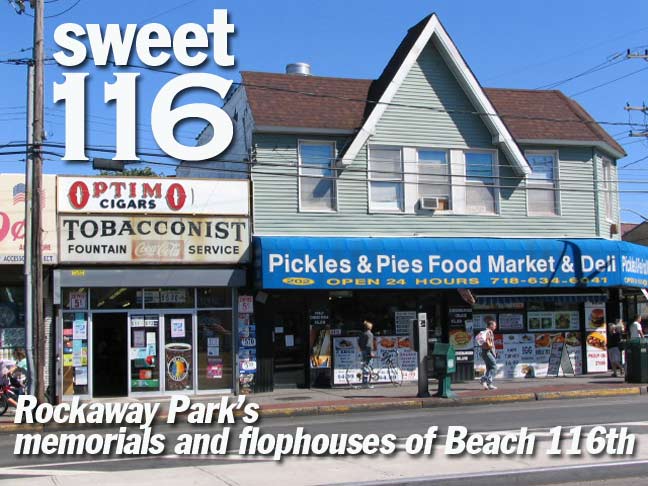
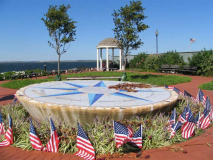
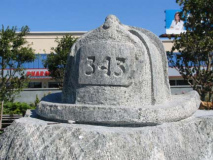
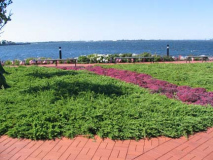

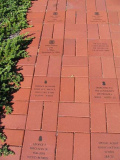

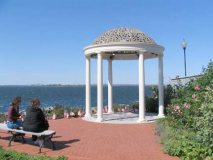
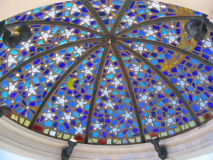
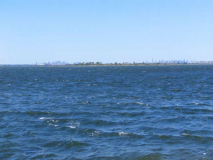
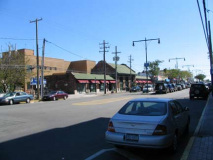
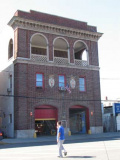
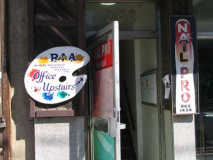
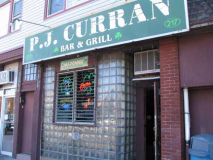

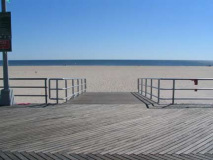

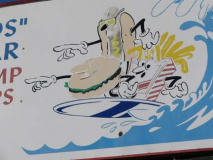
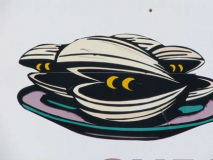
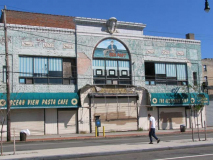
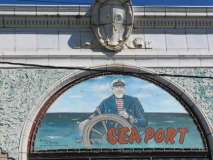
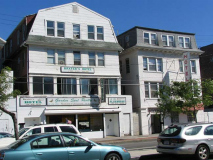
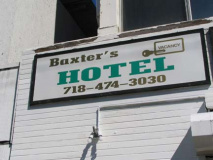
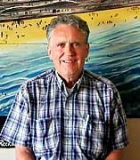

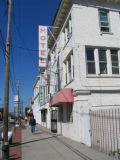
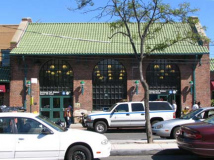
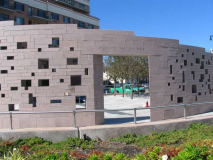
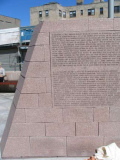
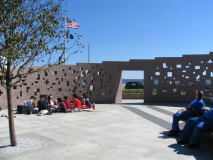

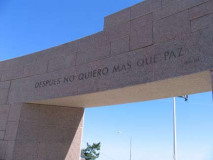
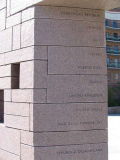
1 comment
[…] The 9/11 Tribute Park is located on the corner of Beach 116th Street and Beach Channel Drive in Belle Harbor, Far Rockaway Peninsula, Queens. The park and monuments is dedicated to the 70 residents of Rockaway Park, as well as the 343 firefighters who died on September 11, 2001. […]
Comments are closed.